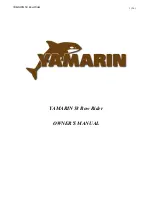
Tacking and Gybing
by Hobie Cat USA
Hobie University, NAHCA
Page 12
30 Mar 02
Turning into the Wind
Turning into the wind, or coming about, is the most
common sailing maneuver: When coming about, the
object is to pass the bows of the boat through the eye
of wind and over to the other side. Let's refer to the
clock example. Suppose you are sailing to the ten
o'clock position, but wish to change course and sail to
the two o'clock spot. You would first move the tiller
toward the sail to move the bows through the wind
coming from noon. Then you would straighten the
tiller once the boat is heading on the desired course.
Here's the procedure step by step.
1.
Before coming about, ask yourself what you are
trying to achieve by doing so. Where do you want the
boat to be when you have completed your turn? Ifs a
good idea to pick a spot on land and aim the boat
toward that spot for reference. Remember you must
turn the boat at least 90 degrees or you may stall in the
wind (put yourself in irons).
2.
Push the tiller smoothly but firmly about half the
distance toward the sail while letting the mainsheet out
about one foot.
3.
As the boom swings over duck and move to the
other side, opposite the new sail position.
4.
Exchange the mainsheet and tiller extension in
your hands. The mainsheet should always be in your
forward hand, the tiller extension should always be in
your aft hand.
5.
Straighten the tiller after you have completed
your turn and the boat is moving toward your
reference point.
Notes:
Move the tiller firmly but avoid sudden,
jerky moves. Try to carve a smooth arc in the water.
Forcing the tiller all the way over will put on the
brakes and put the boat in irons (or stall it). Don’t let
go of the tiller or the boat will straighten out before
you want it to. When tacking a catamaran with a jib
sail, keep the jib sheet cleated until the bows are fully
through the eye of the wind. Then release the jib sheet
and
pull it in on the other side. This is called
"backwinding."
Turning Away From the Wind
Turning away from the wind, or gybing (sometimes
spelled jibing), is changing course while sailing
downwind. Just think of gybing as the opposite of
coming about. When coming about bows cross the
wind. The
sterns
cross the wind when gybing. When
gybing in light air you will probably have to give the
boom some help in swinging across to the other side
of the boat.
To gybe, just pull the tiller extension toward your
body with the same smooth motion as when coming
about, grab the mainsheet just below the boom, and,
when the sterns cross the wind, warn the crew and
swing the boom across. As soon as the sail begins to
fill with wind, move to the other side of the boat and
off you go.
Gybing in heavy air can be more difficult since every-
thing will have to be speeded up correspondingly. In
heavy air, the boom can snap across with a lot of
force. For this reason, ifs best to come about in heavier
winds until you have had a chance to practice gybing
to the point where you feel confident that you can
handle heavy air with dexterity. You should be
especially aware of wind shifts in heavy air. If the
wind should suddenly change direction as it blows
across the stern of the boat, it could grab the sail and
swing it far out to the other side very quickly. This is
an unplanned gybe and could damage the boat if the
wind is strong enough, or it could cause injury to
unaware crewmembers.
















































